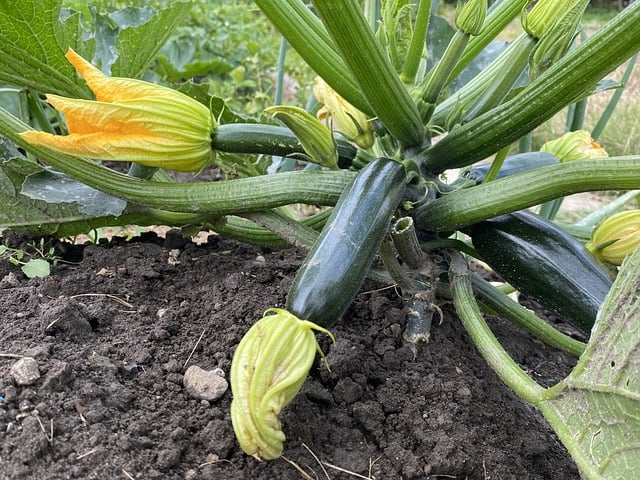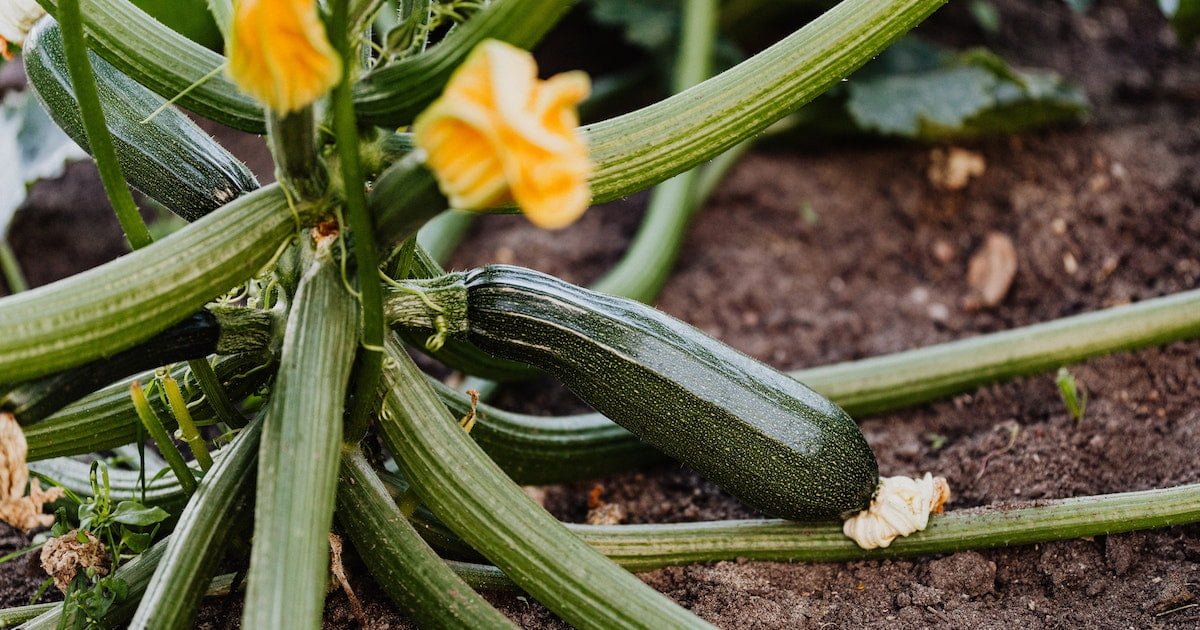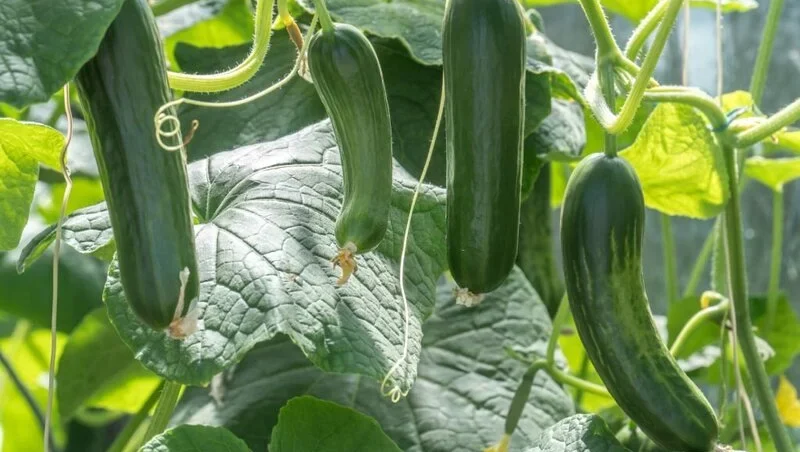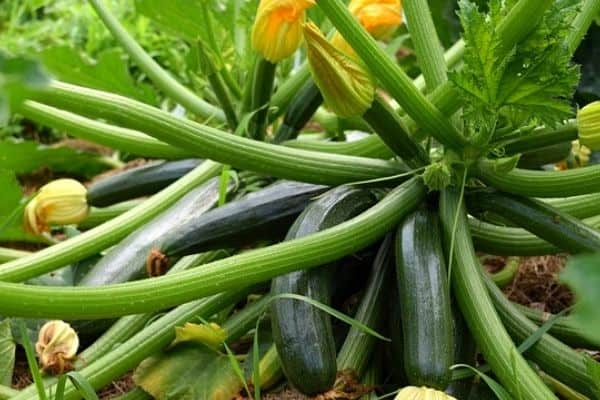So you’ve planted some zucchini plants and now you’re wondering how much delicious and crispy zucchini you can expect to harvest? Well, look no further because we’ve got you covered! In this article, we’ll give you all the tips and tricks you need to determine the yield of your zucchini plants. From calculating the average weight of each zucchini to estimating the total number of fruits per plant, we’ll help you gain a better understanding of just how bountiful your zucchini harvest will be. So grab your gardening gloves and let’s dive into the world of zucchini yields!

Factors Affecting Zucchini Yield
When it comes to maximizing the yield of your zucchini plants, there are several important factors to consider. These factors play a crucial role in determining the overall productivity of your plants and can significantly impact the quantity and quality of your zucchini harvest.
Genetic Potential
The genetic potential of a zucchini variety is one of the primary factors that influence its yield. Different varieties have varying levels of productivity, with some being naturally more prolific than others. When selecting zucchini seeds or seedlings, it is essential to choose varieties that are known for high yields, as this can greatly increase your chances of a bountiful harvest.
Climate Conditions
The climate conditions in your region have a significant impact on the yield of your zucchini plants. Zucchinis thrive in warm weather, with temperatures ranging between 70-85°F (21-29°C). They require a long growing season with an average of 60-80 days from planting to harvest. If your climate experiences extreme heat or long periods of cold, it may negatively affect the yield and growth of your zucchini plants.
Soil Quality
The quality of the soil in which your zucchini plants are grown plays a vital role in their overall yield. Zucchinis prefer well-draining soil with a pH level between 6.0 and 7.5. It is crucial to ensure that the soil is rich in organic matter and adequately nourished with the necessary nutrients. Conducting a soil test can help determine the pH level and nutrient composition of your soil, allowing you to make any necessary amendments to optimize its quality for zucchini production.
Watering
Proper watering is essential for the growth and yield of zucchini plants. These plants require consistent moisture levels in the soil, but it is crucial not to overwater them as it can lead to root rot and other issues. It is recommended to water the plants deeply but infrequently, ensuring that the soil is evenly moist throughout the growing season. Adequate watering is particularly important during flowering and fruiting stages to promote optimal fruit production.
Nutrient Availability
The availability of essential nutrients in the soil is crucial for the development and yield of zucchinis. Macronutrients such as nitrogen, phosphorus, and potassium, as well as micronutrients like calcium, magnesium, and zinc, are vital for healthy plant growth. Proper application of fertilizers and organic amendments can help provide the necessary nutrients and promote optimal zucchini yield.
Pollination
Pollination is a crucial factor that directly affects the yield of zucchini plants. Zucchinis rely on bees and other pollinators to transfer pollen between the male and female flowers, enabling the development of fruits. Without proper pollination, zucchinis may fail to produce fruits or have deformed ones with reduced yields. Implementing practices to attract pollinators, such as planting pollinator-friendly flowers nearby or hand-pollinating the flowers, can significantly improve the pollination process and increase zucchini yield.
Pest and Disease Management
Effective pest and disease management is vital for maximizing zucchini yield. Common pests that affect zucchini plants include squash bugs, cucumber beetles, and powdery mildew. Implementing integrated pest management techniques, such as regularly inspecting plants for signs of pests or diseases, removing affected plants, and using organic pest control methods when necessary, can help prevent and manage infestations. Taking preventive measures, such as crop rotation and proper spacing, can also minimize the risk of pests and diseases and promote higher zucchini yields.
Choosing Zucchini Varieties for Higher Yield
Selecting the right zucchini varieties can significantly impact the overall yield of your plants. By choosing varieties that are known for their high productivity and resilience, you set the stage for a successful harvest. Here are some factors to consider when choosing zucchini varieties for higher yield:
Hybrid Varieties
Hybrid zucchini varieties are known for their high yield potential. These varieties are bred by crossing different parent plants to create offspring with desirable traits, such as disease resistance, improved productivity, and uniformity. By choosing hybrid varieties, you can benefit from their increased production capacity and often have a more consistent harvest.
Open-Pollinated Varieties
Open-pollinated zucchini varieties are another option to consider when aiming for higher yield. These varieties are not bred through controlled crosses but rather rely on natural pollination by wind, insects, or other means. While open-pollinated varieties may not always match the productivity of hybrids, they offer the advantage of producing seeds that can be saved and replanted in subsequent years, maintaining their genetic traits.
Disease-Resistant Varieties
Disease-resistant zucchini varieties are specifically bred to withstand or tolerate common diseases that affect zucchinis, such as powdery mildew or cucumber mosaic virus. By choosing disease-resistant varieties, you can lower the risk of yield loss due to disease outbreaks. It is recommended to select varieties labeled as resistant to diseases prevalent in your region to maximize yield potential.
Early Maturing Varieties
If you’re looking to harvest zucchinis sooner, selecting early maturing varieties is a wise choice. Early maturing zucchinis have a shorter time from planting to harvest, allowing you to enjoy a bountiful harvest earlier in the growing season. These varieties can be beneficial in regions with shorter growing seasons or for those who prefer an early harvest.
Determinate vs. Indeterminate Varieties
When selecting zucchini varieties, it is important to consider their growth habit. Determinate varieties tend to have a more compact, bushy growth habit and produce fruits over a shorter period, making them suitable for smaller gardens or containers. Indeterminate varieties, on the other hand, have a more vining growth habit and can produce fruits continuously throughout the growing season, potentially resulting in a higher overall yield.

Preparing the Soil
Proper soil preparation is a crucial step in setting the stage for high zucchini yield. By ensuring that the soil is well-suited for zucchini growth, you provide the plants with a healthy foundation for productive growth. Here are some essential steps to take when preparing the soil for zucchinis:
Soil Testing
Before planting zucchinis, it is recommended to conduct a soil test to assess the pH level and nutrient composition of your soil. Soil testing kits are readily available and allow you to determine if any adjustments are required to optimize the soil conditions for zucchini growth. The ideal pH for zucchinis falls between 6.0 and 7.5, with slightly acidic to neutral conditions being most suitable.
pH Adjustment
If the soil pH is outside the optimal range, making adjustments may be necessary. Adding agricultural lime to raise soil pH or sulfur to lower it can help bring the pH levels into the desired range. It is essential to follow the instructions provided with the soil test kit or consult with a local agriculture extension office for proper pH adjustment recommendations.
Organic Matter Enrichment
Zucchinis thrive in soil rich in organic matter. Adding compost, well-rotted manure, or other organic materials to the soil can significantly improve its structure, fertility, and water-holding capacity. Organic matter also aids in nutrient retention, promotes beneficial microbial activity, and enhances overall soil health, all of which contribute to higher zucchini yields.
Compost Application
Applying compost to the soil before planting zucchinis can provide a nutrient boost and improve soil texture. Spread a layer of compost, approximately 2-4 inches thick, over the planting area and gently incorporate it into the top few inches of soil. The compost will slowly release nutrients during the growing season, ensuring a steady supply for the zucchini plants.
Mulching
Applying mulch around zucchini plants offers several benefits, including moisture conservation, weed suppression, and temperature moderation. Organic materials such as straw, wood chips, or shredded leaves make excellent mulch options. Apply a layer of mulch around the zucchini plants, taking care to keep it a few inches away from the stems to prevent rotting. Mulching helps maintain optimal soil moisture levels, reducing the stress on the plants and promoting higher yields.
Providing Optimal Growing Conditions
Creating the right growing conditions for zucchinis is essential to maximize their yield potential. By paying attention to factors such as temperature, sunlight, spacing, and support structures, you can create an environment that promotes vigorous growth and abundant fruit production.
Temperature
Zucchinis thrive in warm temperatures, with an optimal range between 70-85°F (21-29°C). Ensure that the plants are exposed to these temperatures during the growing season to promote healthy growth and fruit development. If your climate has cooler temperatures or short growing seasons, you can extend the growing season by using row covers or starting plants indoors before transplanting.
Sunlight
Zucchinis are sun-loving plants that require full sun to thrive. Select a planting location that receives at least 6-8 hours of direct sunlight daily. Adequate sunlight exposure helps stimulate photosynthesis, energy production, and fruit development, all of which contribute to higher yield potential.
Spacing
Providing adequate spacing between zucchini plants is crucial for proper airflow and sunlight penetration. Crowded plants can lead to increased humidity, poor air circulation, and a higher risk of disease. Space zucchini plants approximately 2-3 feet apart in rows, allowing sufficient room for the plants to grow and mature without competing for resources.
Support Structures
While zucchinis are generally bushy plants, some varieties can benefit from support structures to prevent sprawling and to keep the fruits off the ground. Using trellises or cages can help train the zucchini vines upwards, creating a more efficient use of space and potentially higher yields. Make sure to choose a support structure that is sturdy enough to hold the weight of the plants and fruits.

Appropriate Watering Techniques
Proper watering is essential for the health and yield of zucchini plants. Consistent moisture levels in the soil help prevent stress, maintain turgidity in the plants, and support optimal growth and fruit production. Here are some tips for appropriate watering techniques:
Watering Frequency
Zucchinis require regular watering to ensure consistent moisture levels in the soil. Water deeply, ensuring that the water reaches the roots, rather than shallowly wetting the surface. Aim to water the plants 1-2 inches per week, depending on weather conditions and soil moisture levels. Adjust watering frequency as needed to maintain optimal soil moisture for healthy growth.
Avoiding Overwatering
While providing adequate moisture is important, overwatering zucchini plants can lead to several issues, including root rot, poor nutrient uptake, and reduced yields. It is crucial to strike a balance between providing enough moisture and avoiding excess water retention. To prevent overwatering, ensure that the soil has good drainage and allow the top inch or two to dry out before watering again.
Irrigation Methods
There are several irrigation methods to choose from when watering zucchini plants. Hand watering with a hose or watering can is a common and effective method, providing greater control over the amount of water applied. Drip irrigation systems or soaker hoses can also be used, delivering water directly to the root zone and minimizing water loss through evaporation. Whichever method you choose, ensure that the water penetrates deep into the soil to encourage strong root growth and maximize zucchini yield.
Implementing Proper Nutrient Management
Providing the right nutrients at the proper stages is vital for the growth and productivity of zucchini plants. By understanding their macronutrient and micronutrient requirements, as well as implementing appropriate fertilizer application and organic amendments, you can optimize nutrient availability and promote higher zucchini yields.
Understanding Macronutrients and Micronutrients Requirements
Zucchinis have specific macronutrient and micronutrient requirements for healthy growth and fruit production. Macronutrients, such as nitrogen (N), phosphorus (P), and potassium (K), are needed in larger quantities and play crucial roles in different aspects of plant growth. Micronutrients, including calcium (Ca), magnesium (Mg), and zinc (Zn), are required in smaller amounts but are equally essential for optimal growth.
Fertilizer Application
Applying fertilizer at the right time and in the correct amounts is crucial for achieving high zucchini yields. Before planting, incorporate a balanced organic fertilizer into the soil following the package instructions or the results of your soil test. This provides a good initial nutrient base for the plants. Once the zucchini plants begin to establish, side-dress them with a high-nitrogen fertilizer to encourage vigorous growth and fruit development.
Foliar Feeding
Supplementing zucchini plants with foliar fertilization can provide a quick boost of nutrients and encourage higher yields. Foliar sprays are applied directly to the leaves, allowing for efficient nutrient absorption. Use a liquid fertilizer specifically formulated for foliar feeding and apply it during the early morning or late afternoon when the stomata on the leaves are open. Follow the manufacturer’s instructions for application rates and frequency.
Supplementing with Organic Amendments
In addition to fertilizers, organic amendments can help boost nutrient availability and promote healthy zucchini growth. Materials such as compost, aged manure, or worm castings can be applied around the base of the plants or incorporated into the soil during the growing season. Organic amendments enrich the soil with essential nutrients, improve soil structure, and enhance overall plant health, all of which contribute to higher zucchini yields.

Promoting Effective Pollination
Proper pollination is crucial for the development of zucchini fruits. Without effective pollination, zucchinis may fail to produce fruits or have misshapen and low-quality ones. To promote optimal pollination and maximize yield, consider these strategies:
Attracting Pollinators
Encouraging pollinators, such as bees, butterflies, and other beneficial insects, to your garden can significantly improve pollination rates and enhance zucchini yields. Planting a diverse array of nectar-rich flowers nearby, avoiding the use of pesticides harmful to pollinators, and providing suitable nesting and resting places can attract and support pollinator populations.
Hand Pollination
Hand pollination can be a useful technique, especially if natural pollinators are scarce in your area. To hand-pollinate zucchini plants, use a small brush or cotton swab to collect pollen from the male flowers and transfer it to the female flowers. Gently brush the pollen inside the female flowers, ensuring thorough coverage of the stigma. Hand pollination helps overcome pollination challenges and ensures a higher fruit set and yield.
Avoiding Pollination Interference
To maximize pollination success, it is essential to minimize factors that interfere with the natural process. Avoid spraying pesticides or insecticides when the zucchini plants are in bloom, as these can harm pollinators or deter them from visiting the flowers. Additionally, providing proper spacing between zucchini plants and avoiding excessive shading can promote better airflow and accessibility for pollinators.
Protecting Zucchini Plants from Pests and Diseases
Pests and diseases can significantly impact zucchini plants and reduce their yield potential. Implementing effective pest and disease management techniques is crucial for maintaining healthy plants and maximizing zucchini yield. Consider the following strategies:
Identifying Common Zucchini Pests
Familiarize yourself with common pests that can affect zucchini plants. Squash bugs, cucumber beetles, and vine borers are among the most prevalent pests that can cause damage to zucchinis. Regularly inspect your plants for signs of pest infestations, such as egg clusters, chewed leaves, or wilting vines, and take immediate action to prevent further damage.
Implementing Integrated Pest Management
Integrated Pest Management (IPM) techniques can help manage pests while minimizing environmental impact. IPM involves various strategies, including cultural practices, biological controls, and selective pesticide use as a last resort. By incorporating IPM principles, such as crop rotation, companion planting, or using beneficial insects, you can effectively control pests and protect your zucchini plants from damage.
Preventive Measures for Diseases
Preventing diseases is crucial for sustaining zucchini yield. Common zucchini diseases include powdery mildew, downy mildew, and bacterial wilt. To minimize disease occurrence, practice good garden hygiene by removing and disposing of diseased plant material, avoiding overhead watering, and providing adequate spacing and airflow between plants. Choosing disease-resistant varieties, as mentioned earlier, can also provide an added layer of protection against common diseases.

Harvesting Zucchini for Optimal Yield
Knowing when and how to harvest zucchinis is essential to maximize their yield potential. By following suitable harvesting techniques, you can ensure a continuous supply of fresh zucchinis and encourage the plants to produce more. Consider these guidelines for optimal zucchini harvest:
Determining the Right Time
Zucchinis should be harvested at the right stage of maturity to ensure the best flavor and texture. For most zucchini varieties, it is recommended to harvest when the fruits are 6-8 inches long and firm. Avoid overripe zucchinis with tough skin and large seeds, as they are less desirable. Regularly inspect the plants and harvest zucchinis as soon as they reach the desired size.
Proper Harvesting Techniques
To harvest zucchinis, use a sharp knife or pruning shears to cut the fruits from the plant, leaving a short stem attached. Avoid twisting or pulling the fruits, as this can damage the plant or cause breakage. Handle the harvested zucchinis gently to prevent bruising or other physical damage.
Continual Harvesting
Zucchini plants are known for their rapid fruit production, often producing more than can be consumed at once. Continual harvesting is essential to keep the plants productive and encourage further fruit development. Check your zucchini plants regularly, preferably daily, and harvest any ripe fruits to maintain a steady supply. Promptly remove any overripe or damaged zucchinis to prevent them from inhibiting further fruit development.
Storing and Preserving Zucchini
Whether you have an abundant harvest or want to extend the availability of zucchinis beyond the growing season, proper storage and preservation methods are crucial. Here are some techniques for storing and preserving zucchinis:
Storing Fresh Zucchini
Fresh zucchinis can be stored in a cool, dry place away from direct sunlight for up to a week. Alternatively, they can be stored in the refrigerator in a perforated plastic bag to maintain freshness for up to two weeks. It is best to use the zucchinis as soon as possible after harvest to enjoy their optimal taste and texture.
Freezing Zucchini
Freezing is a popular method for preserving zucchini for an extended period. To freeze zucchini, wash, slice, and blanch the zucchini pieces in boiling water for a minute or two, then transfer them to an ice bath to stop the cooking process. Pat them dry, pack them in airtight freezer bags or containers, and label them with the date. Frozen zucchini can be stored for up to eight months.
Canning Zucchini
Canning zucchini is another preservation method that allows you to enjoy zucchinis throughout the year. Zucchini can be canned in the form of pickles, relishes, or chutneys. Follow a trusted canning recipe and ensure that proper sterilization and processing techniques are used to maintain safety and quality.
Dehydrating Zucchini
Dehydrating zucchini is a great option for long-term storage and creating versatile dried zucchini chips or flakes. Slice the zucchinis into thin, even pieces and dehydrate them using a food dehydrator or an oven set to the lowest temperature. Once fully dehydrated, store the zucchini in airtight containers away from heat and humidity. Properly dehydrated zucchinis can last for months and be used as an ingredient in various recipes.
In conclusion, maximizing zucchini yield entails considering a range of factors that contribute to the overall health and productivity of the plants. By selecting appropriate varieties, preparing the soil, providing optimal growing conditions, implementing proper watering and nutrient management techniques, promoting effective pollination, and protecting against pests and diseases, you can significantly increase your zucchini yield. Furthermore, harvesting the fruits at the right time, storing and preserving them using proper methods, allows you to enjoy the harvest for months to come. With careful attention and consideration of these factors, you’ll be well on your way to a plentiful zucchini harvest year after year.



